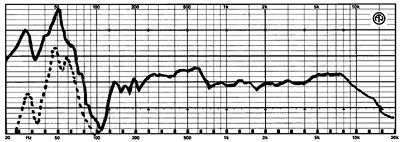
|
Speaker Asylum General speaker questions for audio and home theater. |
|
In Reply to: RE: The best bass (below 100 Hz) you have heard posted by layman on December 2, 2014 at 05:49:45:

Above: Power (in-room) response curve of Focal Grande Utopia BE courtesy of Stereophile.I have experimented with subwoofers and have come to the conclusion that though they can enhance the sounds of explosions and dinosaur foot thumping (sounds occuring below 60 Hz), they don't do much to enhance the realism of recorded piano.
The problems that you have addressed must be happening at a higher frequency. The problems are exacerbated by the modern habit of mounting speakers on stands out near the middle of the room. What I am referring to is known as the "Allison Effect."
Duke discussed how room coupling produces "shelving bass boost" below the frequency at which bass reflections from the room's boundaries and the primary output of the woofer re-inforce each other.
Yet, just above the frequency of "shelving bass boost," there is a region where bass reflections from the room's boundaries and the primary output of the woofer (being out of phase) cancel each other, producing a deep null, a suckout.
The frequency of these nulls can be determined using the following formula:
Frequency of null = 1130 (velocity of sound)/distance (in feet) x .3 (quarter wave co-efficient).
Using this formula you can determine that given the dimensions of a standard room and the habit of mounting speakers on stands, away from boundaries, quarter-wave nulls usually occur in region of 250 Hz to 300 Hz.
A deep null, a suckout (of the speaker's in-room response) between 250 Hz to 300 Hz is particularly destructive of piano music and is the principal reason that the piano ends up sounding denuded and "miniaturized"...you are only hearing the piano's upper notes, it's bottom registers (overlapping with the null) are sucked out of the in-room response.
Furthermore, the primary wave-front of the woofer does not just interact with the reflections coming off the room's boundaries but in a stereo pair of speakers, each speaker's primary wave front will interact with that coming from the other speaker producing the same kind of "shelving bass boost" and quarter wave nulls. In effect, the half point of the distance between the speakers in a stereo pair acts as another boundary.
When the frequency of these boundary induced quarter wave cancellations overlaps, the resulting nulls can be both wide and deep, as can be seen in the linked page of power response measurements of various speakers (courtesy Stereophile).
The trick to minimizing the severity of quarter-wave cancellations is to make sure that the speakers are a different distance from each room boundary (and 1/2 the distance between the speakers) and that none of the distances are multiples of any other.
Edits: 12/02/14 12/02/14
This post is made possible by the generous support of people like you and our sponsors:
Follow Ups
- Allison Effect - layman 06:50:47 12/02/14 (1)
- RE: Allison Effect - Duke 17:33:19 12/02/14 (0)